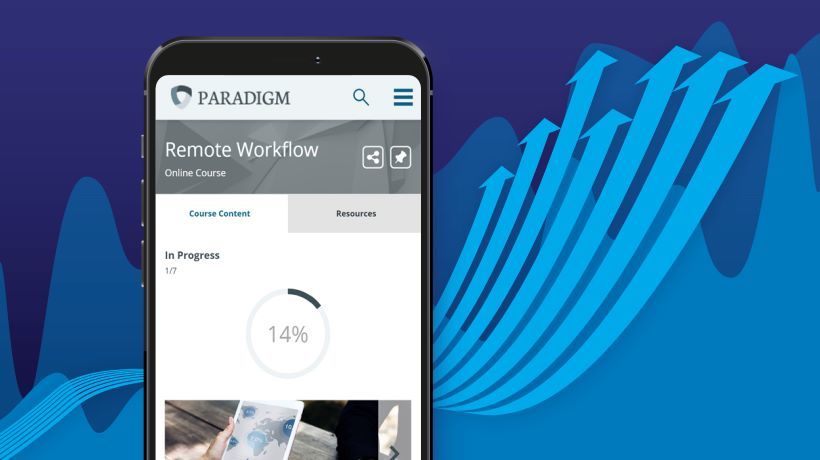Microlearning And The Future Of Corporate Learning And Development
In my earlier article Microlearning In Learning And Development: The Digital Industrial Revolution I discussed the influences of microlearning on corporate Learning and Development. Digital technology is enabling the delivery of on-the-job micro "lessons", very small but relevant information events… when needed. The ubiquity of training at the workplace offers many benefits. This article will investigate these and expand on the last article, providing conceptual implementation scenarios… a look into the possible future of corporate Learning and Development.
Real Time Learning
We are aware of the many current theories and methodologies around training, but more and more we hear the importance of informal learning. Real Time Learning means providing the right information exactly when the user needs it, most often outside of the classroom. Information is presented in small, self-contained units to support building up knowledge quickly. This concept enables learning with small learning units in a workplace context, adapted to the specific user. Users can obtain learning content in the midst of the work process, fitting to their context and the problem at hand. Later, if a user is confronted with the same problem again, the content can easily be obtained and consumed again, until it has been learned deeply.
Microlearning content is designed to enable multiple classes of workers in a way that it can be easily understood, and, can be learned in a short time. As it helps to solve a current problem, it enables operational excellence, improves efficiency, and helps reduce costs. Furthermore, it enables self-learning, gives a feeling of success, and strengthens motivation for further work and learning. In a sense, it empowers and therefore is a new perspective on learning processes in mediated environments. Microlearning is especially common in the eLearning arena catering for different learning styles and media preferences. Examples are: Short text explanations or video sequences, test questions, pictures, screen shots, web based trainings. Also apps, quizzes, and learning games which are commonly used on mobile devices (like smartphones and tablets) can be regarded as a kind of microlearning content.
Digital solutions can work simultaneously with multiple platforms and applications; they can also help employees with offline processes. For instance, if a process involves calling a customer, a digital tool will remind the employee to do that at the appropriate time. Another benefit of digital systems is that users can interact directly with the help desk from within the software. Users simply click on ‘help’ and can take a screenshot of where they are stuck greatly improving Help Desk’s trouble shooting efficiency. These tools also allow employees to leave tips for other users so that everyone can benefit from each other’s knowledge. The effect is a reduction in internal ‘calls for help’, and improved employee satisfaction and confidence in operating enterprise software and processes.
Fitting Microlearning In Your Training Landscape
Microlearning helps empower learners, moving away from a push to a pull learning model. Employees can benefit from microlearning by gaining access to relevant information on demand to solve pressing issues. Microlearning, as a different form of knowledge acquisition, can be executed using digital technologies in its delivery, becoming an important facet of learner motivation and learning outcomes.
Within a digital environment microlearning can support cognitive learning by reducing rhetoric and unnecessary text, purely providing focused (job specific) content. We know that microlearning, as a pedagogy, uses technological support to call for less rather than more work done by the learner, but it also grounded on the execution of frequent learning, i.e. spaced repetition (frequently reviewing materials, etc.). Using digital technology, we can deliver bite sized learning when needed to quickly close skill and knowledge gaps. It seems to be an ideal instructional approach for many situations because information changes quickly and new clever technologies can deliver updated info on demand. This helps make learning for staff easier, as the use the current information, especially that that changes quickly, employs micro content as a foundation for knowledge building.
According to the 70-20-10 model where employees learn up to 80% of their learning on-the-job and through other informal channels (social learning, mentoring, coaching, etc.), implementing technology to deliver this approach would benefit the corporate Learning and Development function. As it takes advantage of the largest contribution to learning according to the model. It would make sense, then, to develop a corporate Learning and Development strategy that takes advantage of these contemporary techniques (considering the pedagogy (teaching method), the technology, and the change management issues involved).
A Future Learning Of Development Scenario
Digital transformation is broadly changing industry value chains at a fast tempo. Within the Internet of Things, data and services products, services, engineering and production processes, as well as infrastructure, will be cross-linked resulting in a highly flexible value chain. ‘Smart products’ like smart watches, heating systems, fire, smoke & intruder alarms; vehicles or machines are continuously collecting data. This fast growing data base represents the basis for smart services.
What does this all mean for basic and advanced employee training and qualification? We believe that in the future a significant part of today’s tasks will be done by computers, robotics and algorithms, or, will be completely automated. The future workplace will change, being comprehensively driven by human machine interaction. The ability of a company to compete will be significantly dependent on the competencies of its employees. The impact of cognitive skills (critical thinking skills needed to solve problems), creativity and social intelligence will rise in the future.
The younger Millennial and Generation X workers expect training and support to be as readily and rapidly accessible as a Google search. In this ‘pull’ model where Learning and Development is a continuous process, with training pulled seamlessly through computers or mobile devices anywhere, anytime. The traditional ‘push’ model of classroom training is being replaced by the mouse click and the screen tap.
As careers become longer and more diverse skills half-life also becomes shorter and shorter, a premium on continuous training and development is determined. New tools now allow employees to continuously upgrade skills by incorporating learning into everyday work experience and progress at their own rate, or as the need requires. Lifelong learning is taking place all the time, not only in a professional context. The approach of 70-20-10 rule addresses the importance of informal learning. The inclusion of learning taking place informally and outside the professional context, provides a ‘win-win situation’ for individual learner and employer alike.
This will be done by tracking learners’ achievements in a central learning record store and asking the learner to share his/her content and experiences with the employer to reflect his/her achievements within the Enterprise to support the personal development of the learner in its actual professional context. Recommendations to optimally support the learners in their personal development are strongly dependent on concrete content. To enhance such a media repository with content addressing topics outside the professional learning context provides an interface for the integration of Open Educational Resources.
Building a strong employee/employer trust relationship will encourage employees to provide evidence of training (either formal or informal) to their current employer. Such training may come in the form of recognized courses performed externally (a certificate could be uploaded, etc.), conference visits, hobbies and pastimes that accrue actual and valuable skills, to even knowledge development through reading online books, posts, and news sites. Providing this information to an employer will help develop a rounded picture of the employee’s skill-set and enable the employer to locate a particular skill-set when needed, or through analysis even identify a new service offering opportunities. The employee will benefit by being able to migrate (take) this information from employer to employer, building up a resume that combines the broad-range of learning activities undertaken.
Future Effects
Current learning opportunities offer both employees and their employers significant advantages. The future employee will consume micro content even if they don’t know that is what they are actually doing. Up-to-date knowledge availability will be simultaneous to everyday work activities. If an employee needs something, instead of searching for help, our technologies will be ready with exactly that what is sought. The employee then, less frustrated, can keep on top of workplace changes and perform. Being knowledgeable about one’s workplace reduces stress, removes reasons to leave the firm, and improves productivity and efficiency.
Employers obviously benefit from happier employees leading to reduced staff turnover and leave claims. Educated employees can perform their job functions well. Organisations increasing their training ROI can benefit significantly. Increased data collection possibilities allow for reporting and improved product production processes, even possible smart consultancy services. Additionally, if a company swiftly reacts to take advantage of a golden opportunity, or repositions in face of a threat, the strategy change can be communicated throughout the organisation at the areas of most impact, on-the-job. In such cases of disruptive change technology can identify areas of skill deficiency and provide direct learning support. The Learning and Development function of the future needs to provide the leadership and planning to meet the challenges suggested above. By doing this they will discover that technology is bringing us tomorrow’s solutions today.
I would like to acknowledge and thank the valuable contributions from both Dr. Helko Lehmann and Koven Minien.









